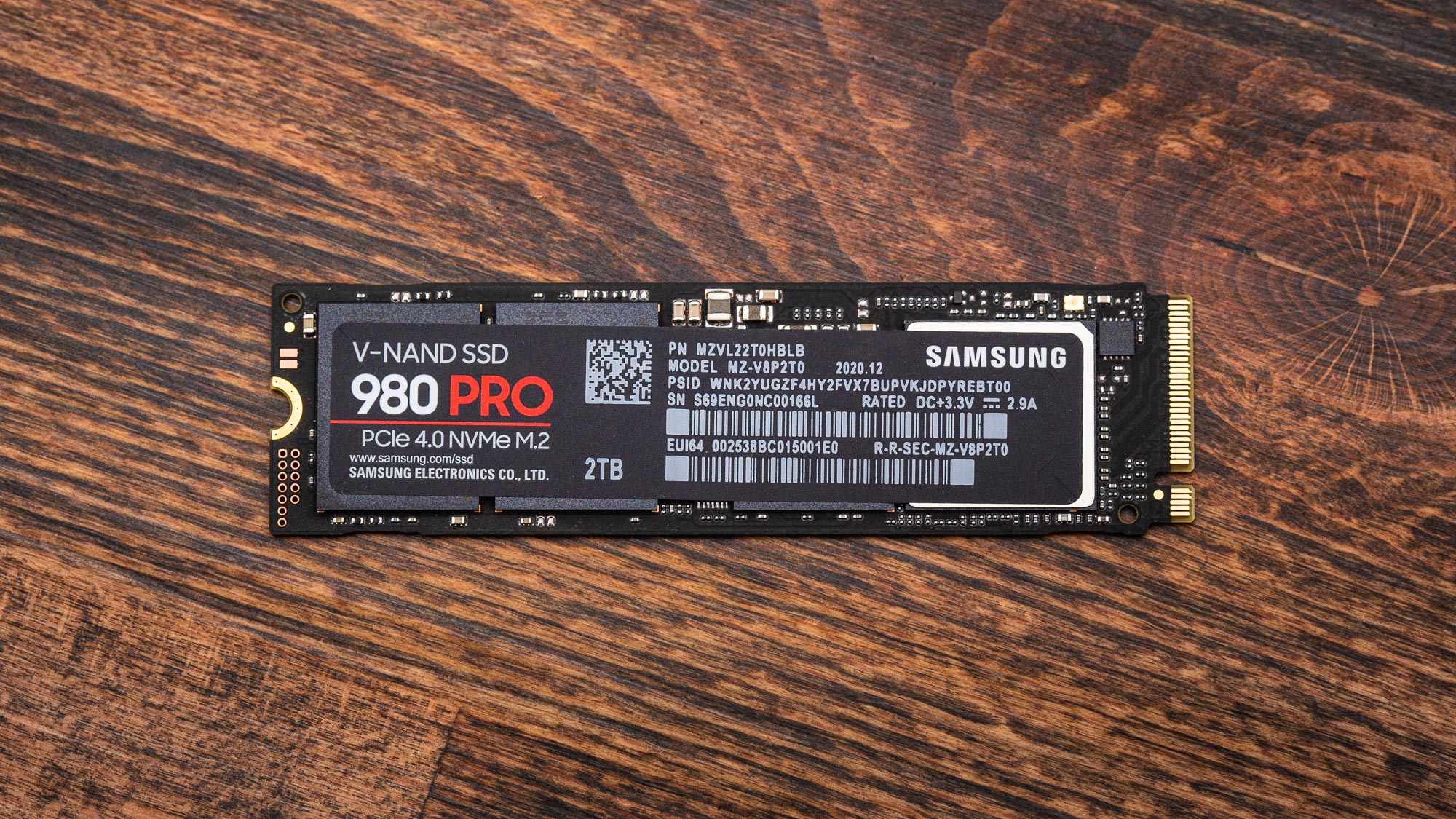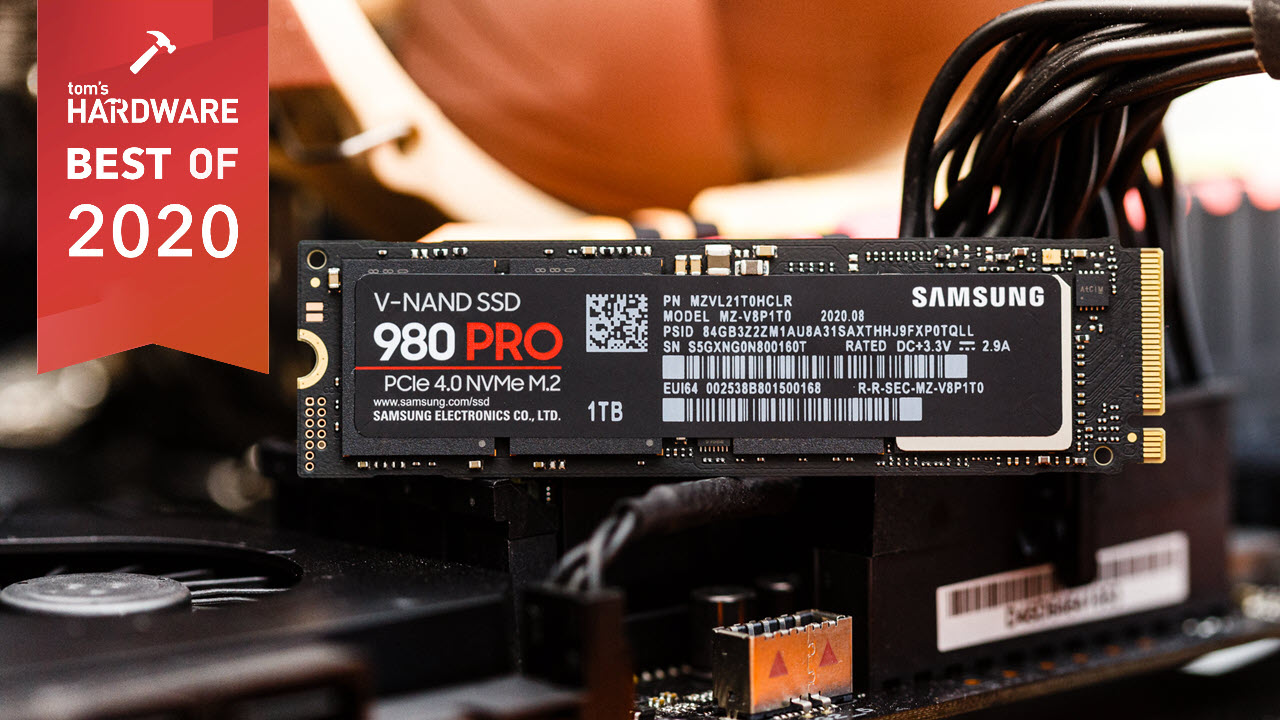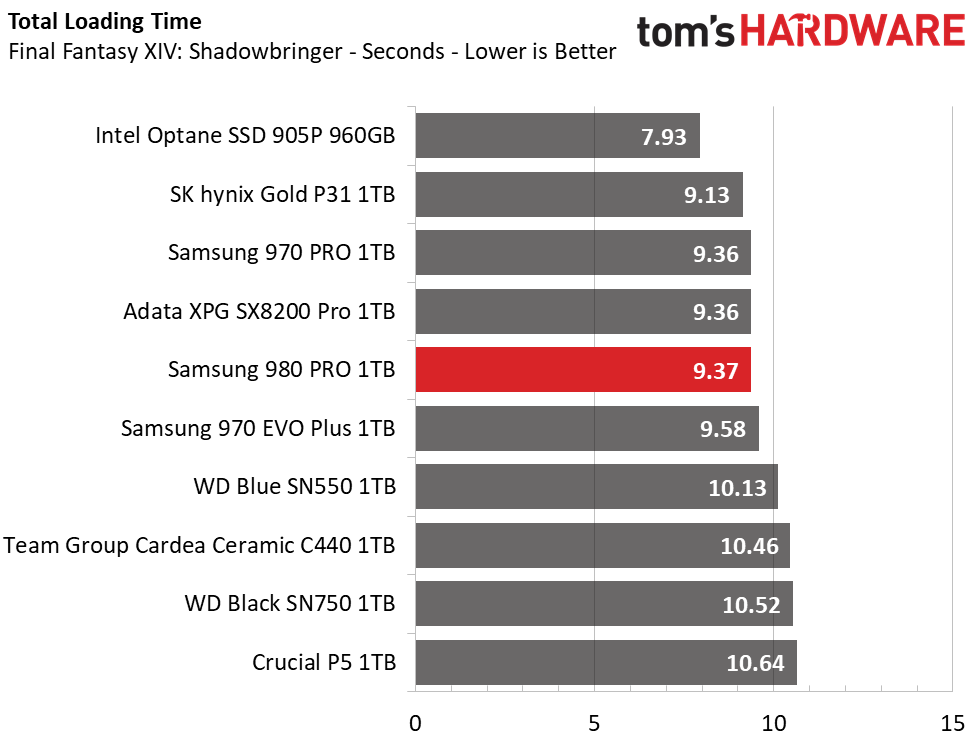Why you can trust Tom's Hardware
Samsung 980 Pro (1TB)
RATING: 4.5 (Editor's Choice)
VERDICT: Are you looking for the best? Look no further. With the fastest performance we have seen from a NAND SSD yet, Samsung’s 980 Pro 1TB makes other NVMe SSDs look slow.
FOR
+ Unrivaled PCIe Gen4 performance
+ AES 256-bit encryption
+ Black PCB
+ Software package
Get Tom's Hardware's best news and in-depth reviews, straight to your inbox.
+ 5-year warranty
AGAINST
- Average endurance ratings
- Costly
Comparison Products
With top specs, it was only fitting to pit Samsung’s 980 Pro up against the best SSDs on the market. We included an SSD based on Phison’s E16 PCIe 4.0 x4 NVMe controller, the Team Group Cardea Ceramic C440, to see which architecture proves best. We also threw in Samsung’s 970 EVO Plus, which comes with the company’s V5 92-Layer V-NAND TLC, and the 970 Pro with V4 V-NAND 64-Layer MLC.
Additionally, we included WD’s Blue SN550 as an entry-level comparison, as well as the high-end WD Black SN750 and Crucial P5. Of course, we couldn’t forget about Adata’s XPG SX8200 Pro, one of the all-around best values, nor SK hynix’s Gold P31, a top pick to consider for efficient computing. For good measure, we threw in Intel’s Optane SSD 905P to define the upper limits of pricey performance.
Game Scene Loading - Final Fantasy XIV
Final Fantasy XIV Stormbringer is a free real-world game benchmark that easily and accurately compares game load times without the inaccuracy of using a stopwatch.
When it comes to game load performance, the differences aren’t that dramatic between the fastest SSDs.Optane proves it’s still the fastest choice, but the Samsung 980 Pro also loads game files very quickly. The 980 Pro nearly ties the 970 Pro and Adata XPG SX8200 Pro and beats the 970 EVO Plus by 0.2 seconds, proving it’s a very capable SSD.
Transfer Rates – DiskBench
We use the DiskBench storage benchmarking tool to test file transfer performance with our own custom blocks of data. Our 50GB data set includes 31,227 files of various types, like pictures, PDFs, and videos. Our 100GB includes 22,579 files with 50GB of them being large movies. We copy the data sets to new folders and then follow-up with a reading test of a newly written 6.5GB zip file and 15GB movie file.
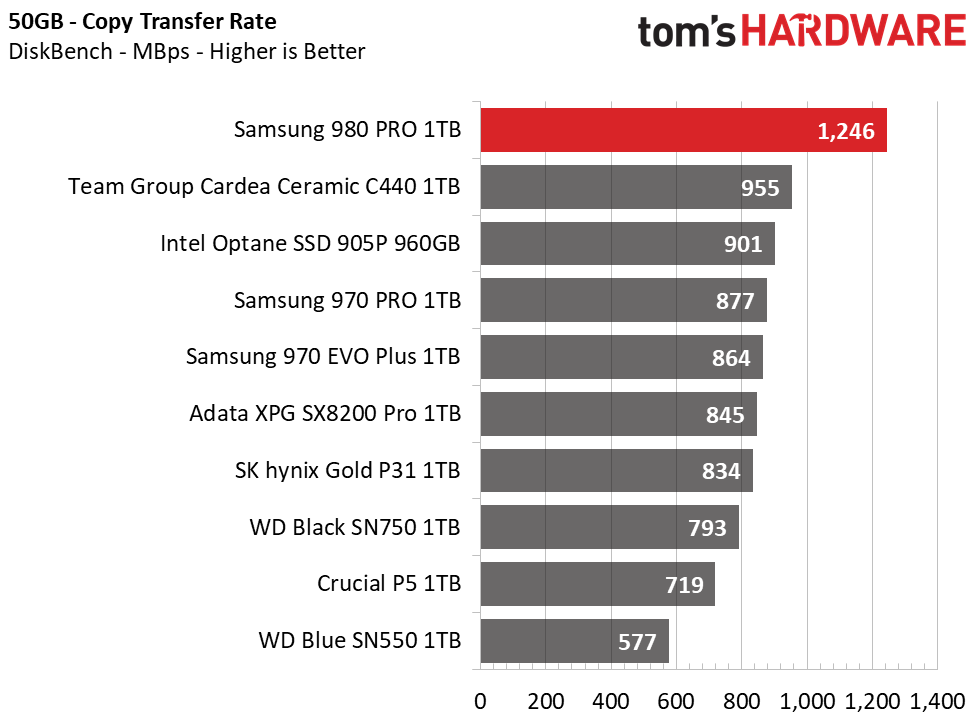

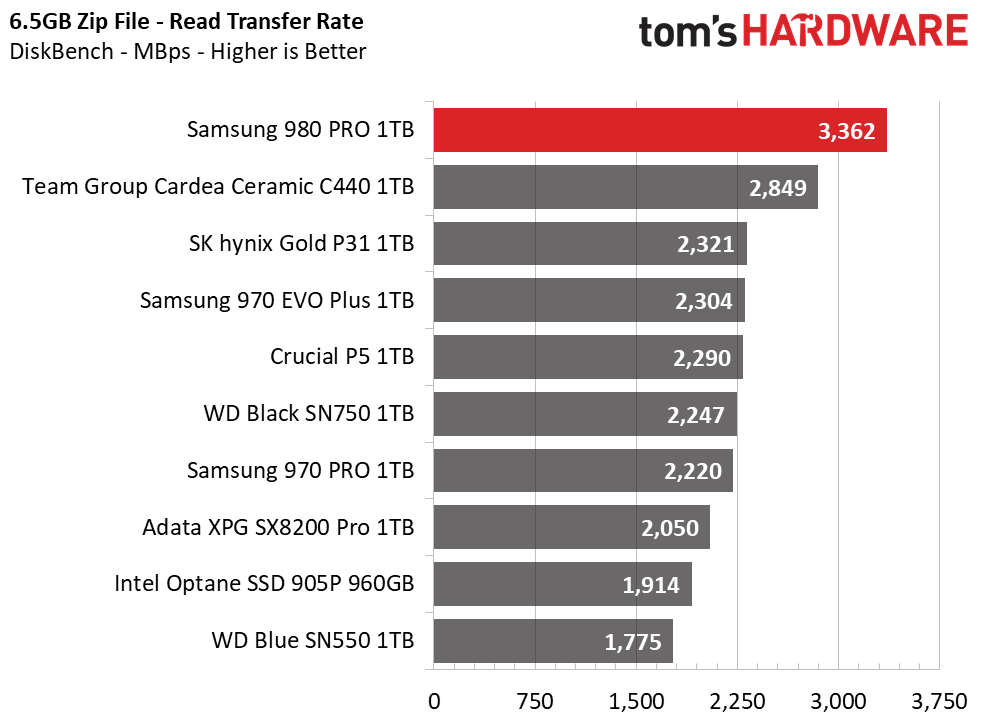
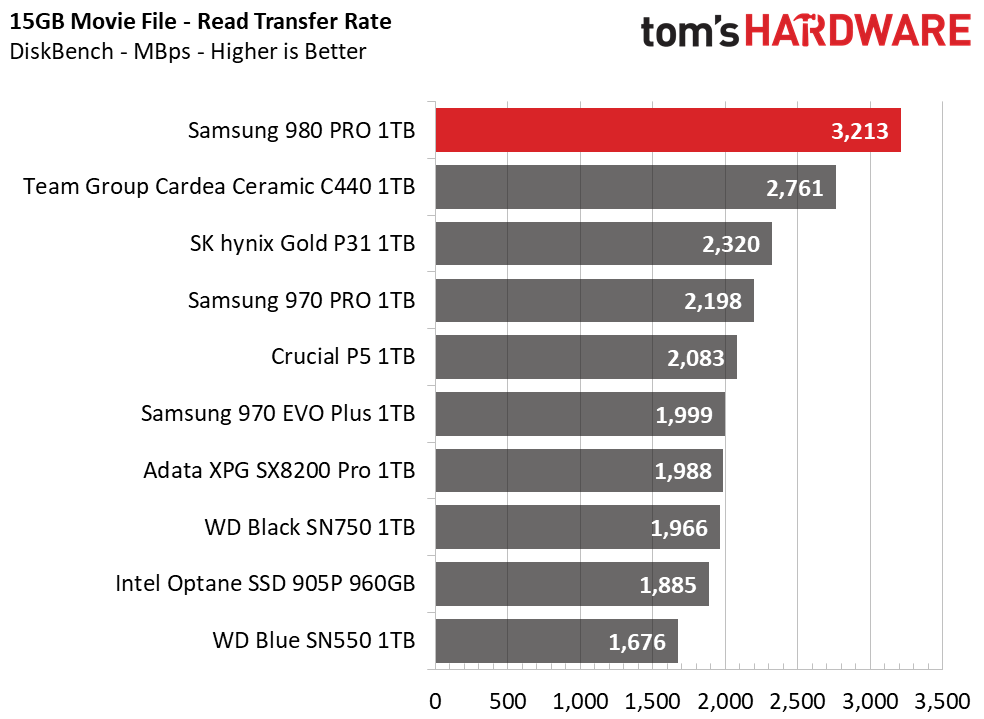
With ample TurboWrite cache space, the 980 Pro's new hardware and firmware is quite potent for those who move large files around often. Samsung's 980 Pro delivers chart-topping file copy and read performance that leaves not only the 970 EVO Plus and 970 Pro in the dust; it's also significantly faster than Team Group's Cardea Ceramic C440.
Trace Testing – PCMark 10 Storage Tests
PCMark 10 is a trace-based benchmark that uses a wide-ranging set of real-world traces from popular applications and common tasks to measure the performance of storage devices. The quick benchmark is more relatable to those who use their PCs for leisure or basic office work, while the full benchmark relates more to power users.
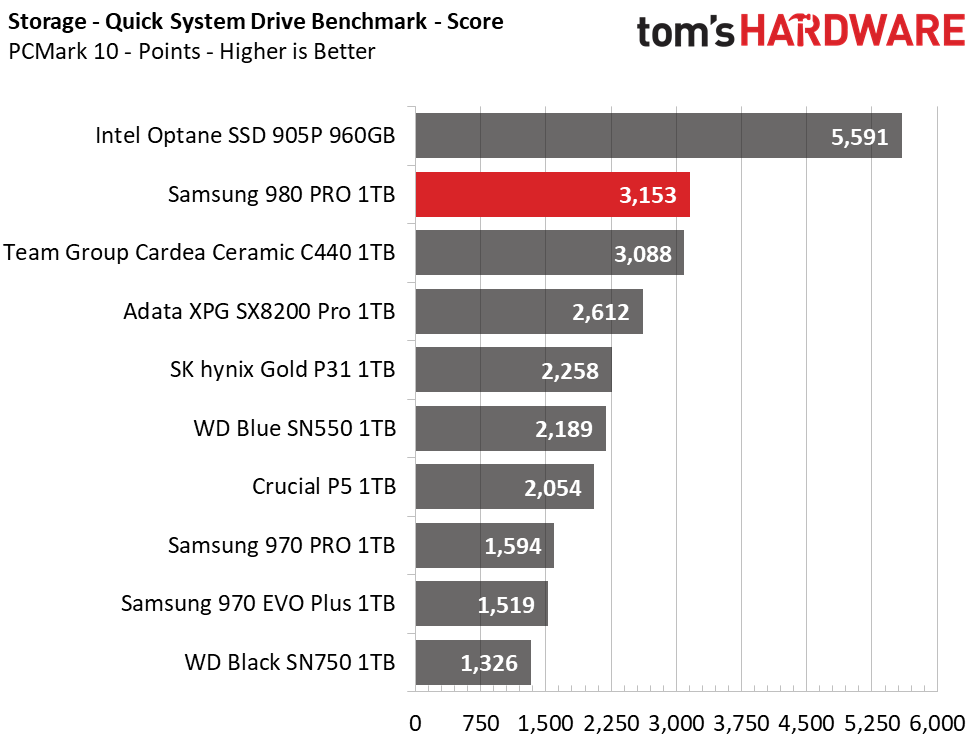

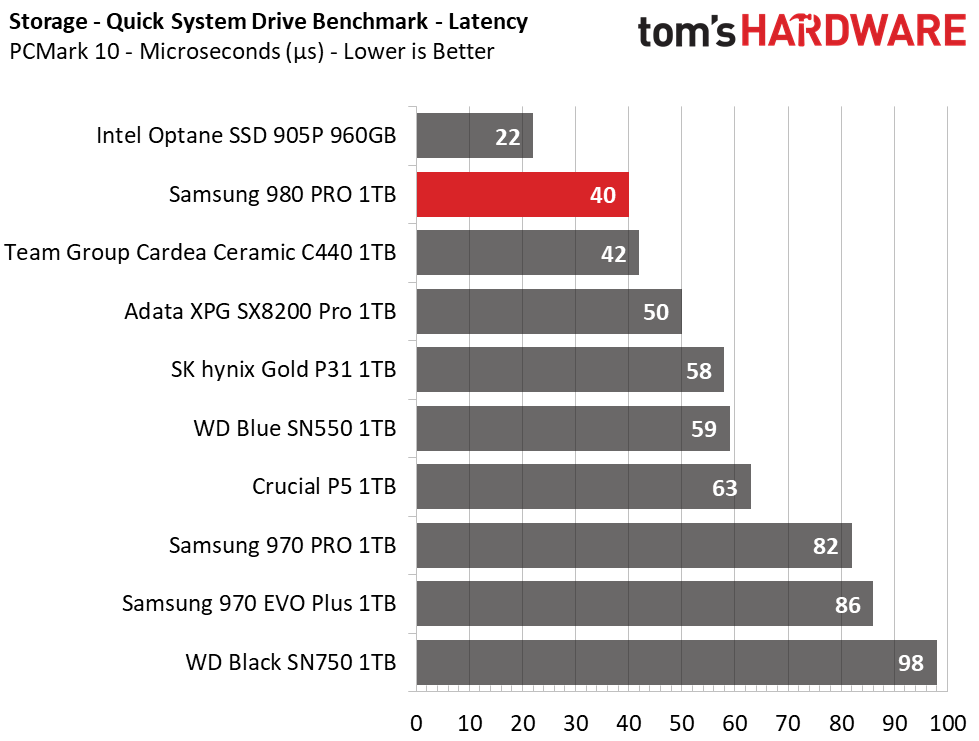
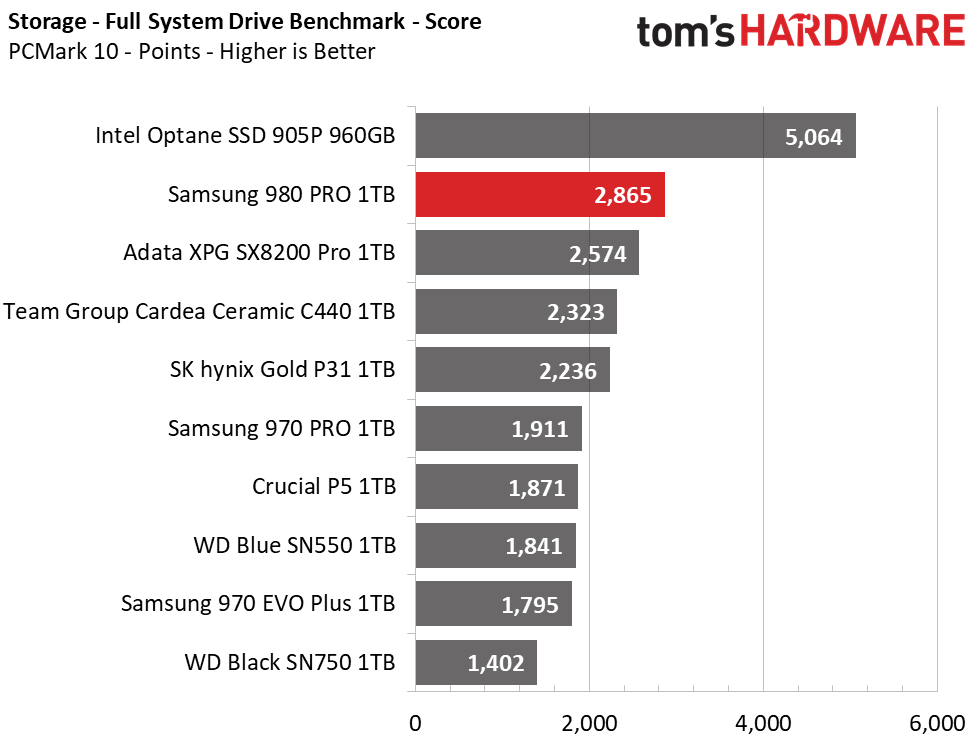
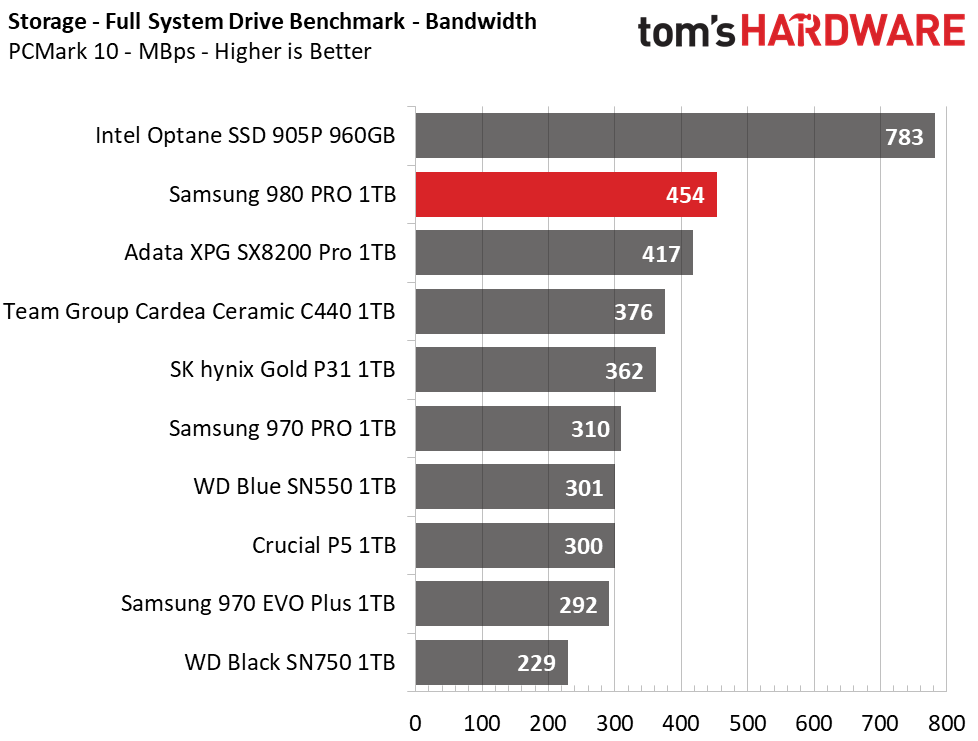

Samsung’s 980 Pro achieves impressive PCMark 10 scores in both the Quick and Full benchmarks, taking the lead over the Team Group Cardea Ceramic C440 as well as all the other high-end NAND-based NVMe SSDs on the market. Only Intel’s Optane SSD 905P is faster, thanks to its Optane media that provides an ultra-low latency Profile.
Trace Testing – SPECworkstation 3
Like PCMark 10, SPECworkstation 3 is a trace-based benchmark, but it is designed to push the system harder by measuring workstation performance in Professional applications.
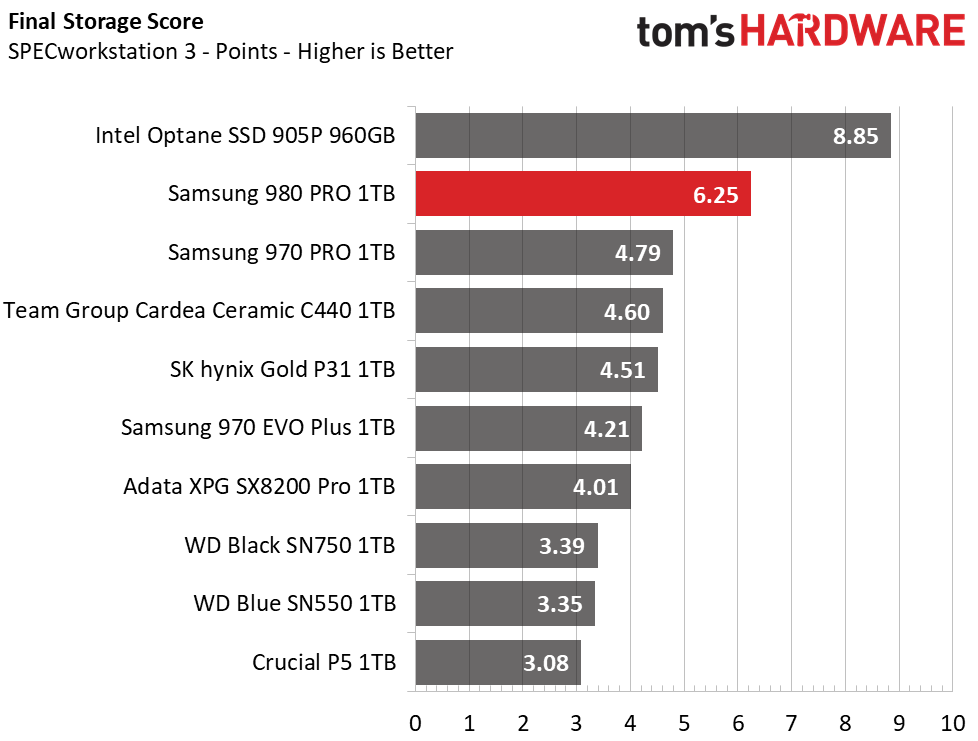
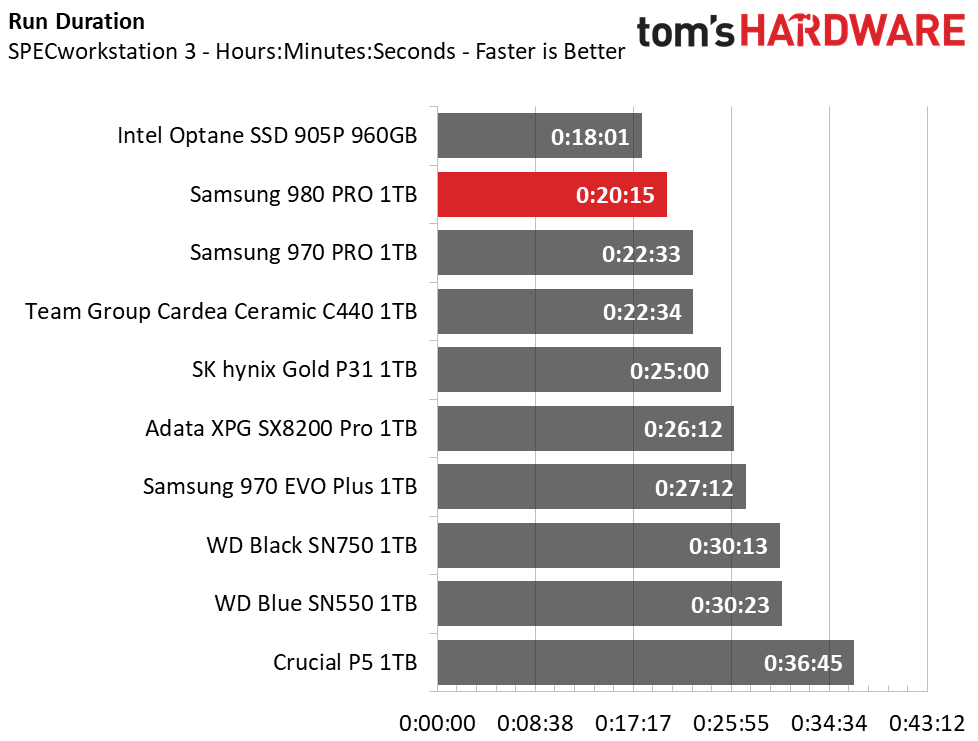
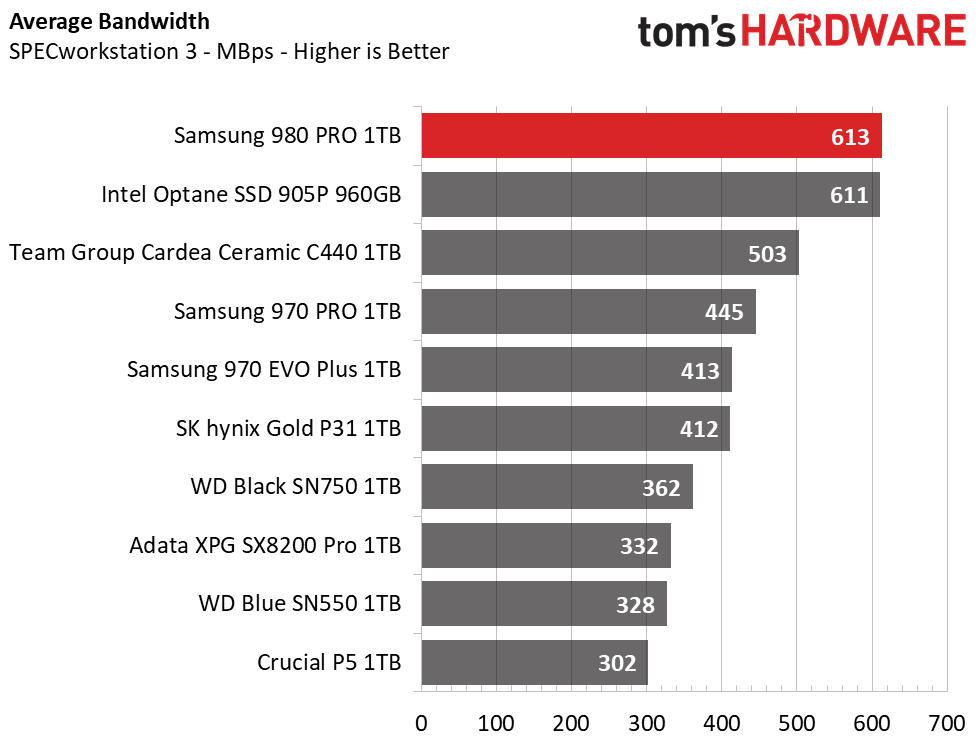
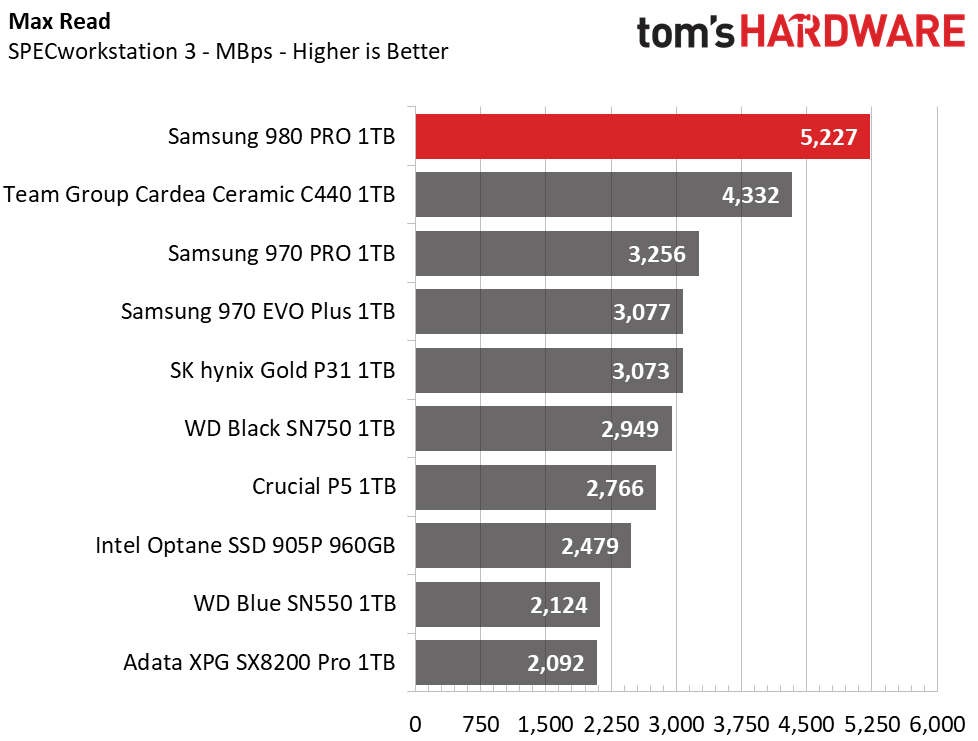
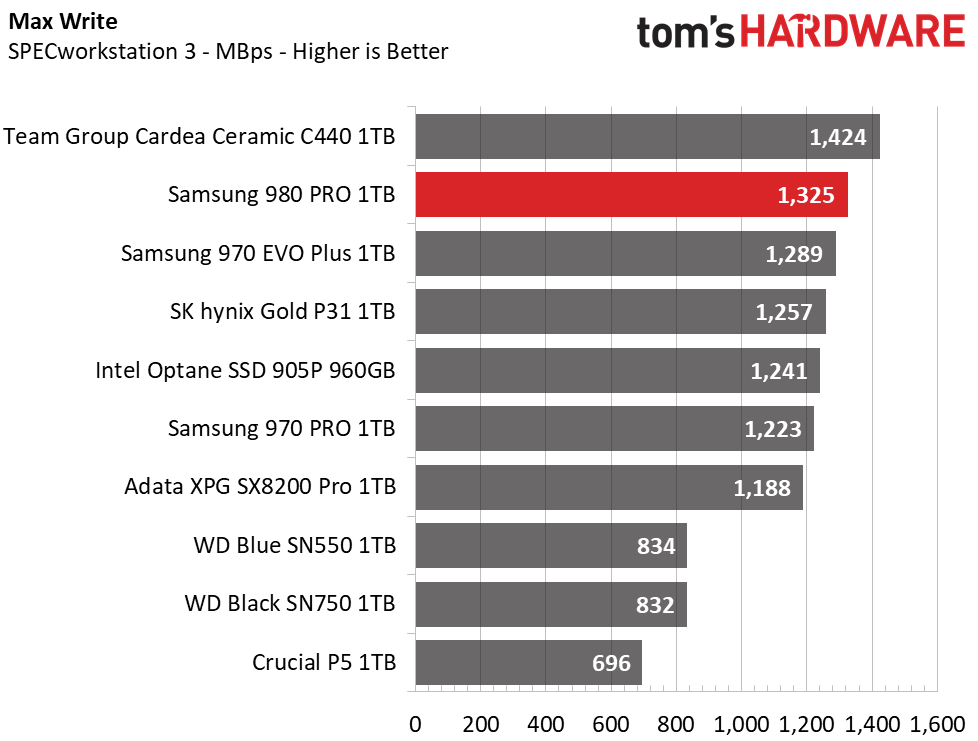
Once again, Samsung's 980 Pro easily tackled the workloads thrown in its way. The drive lands in second place, easily outperforming the company's last-gen NVMe SSDs and taking a big lead over the Team Group Cardea Ceramic C440. It completed the workloads in just over 20 minutes, trailing Intel's Optane SSD 905P by roughly two minutes.
Synthetic Testing - ATTO / iometer
iometer is an advanced and highly configurable storage benchmarking tool while ATTO is a simple and free application that SSD vendors commonly use to assign sequential performance specifications to their Products. Both of these tools give us insight into how the device handles different file sizes.
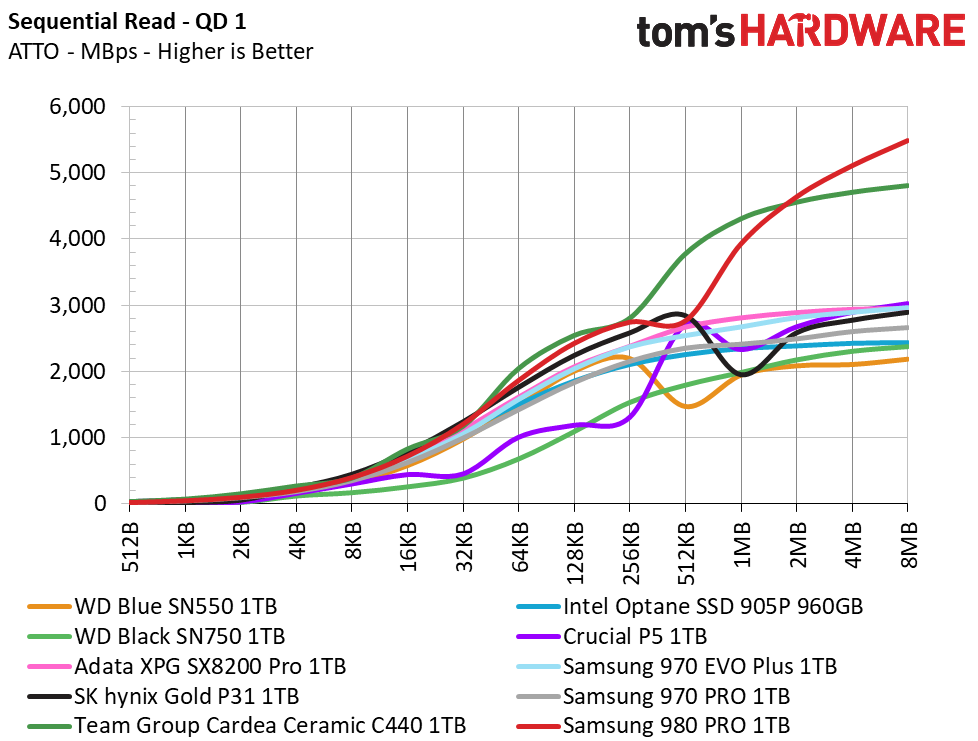
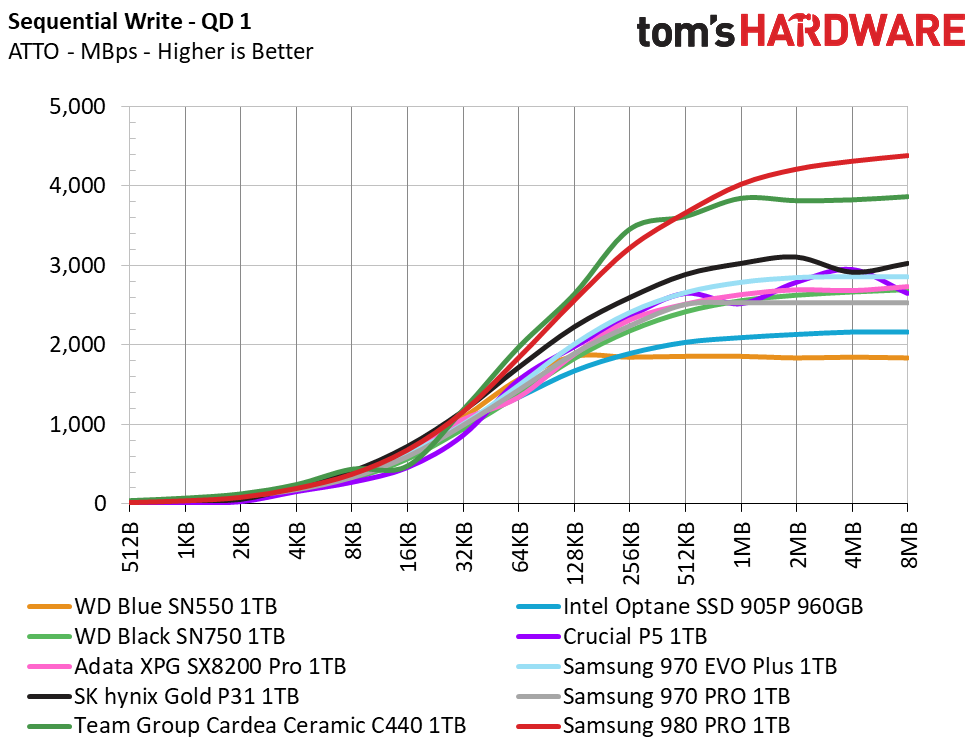
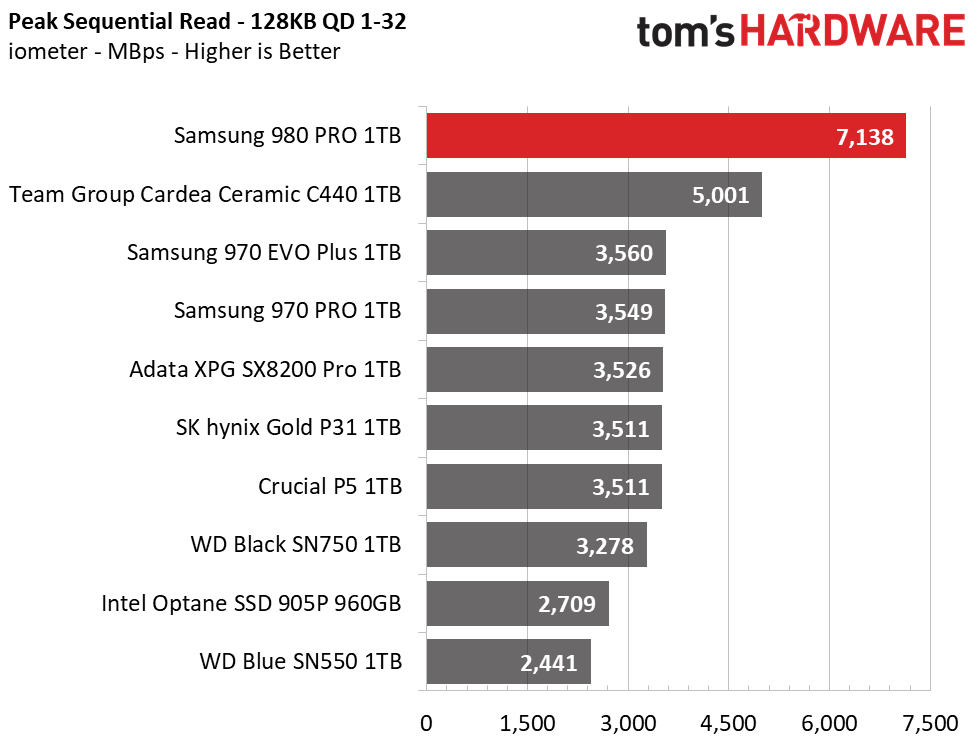
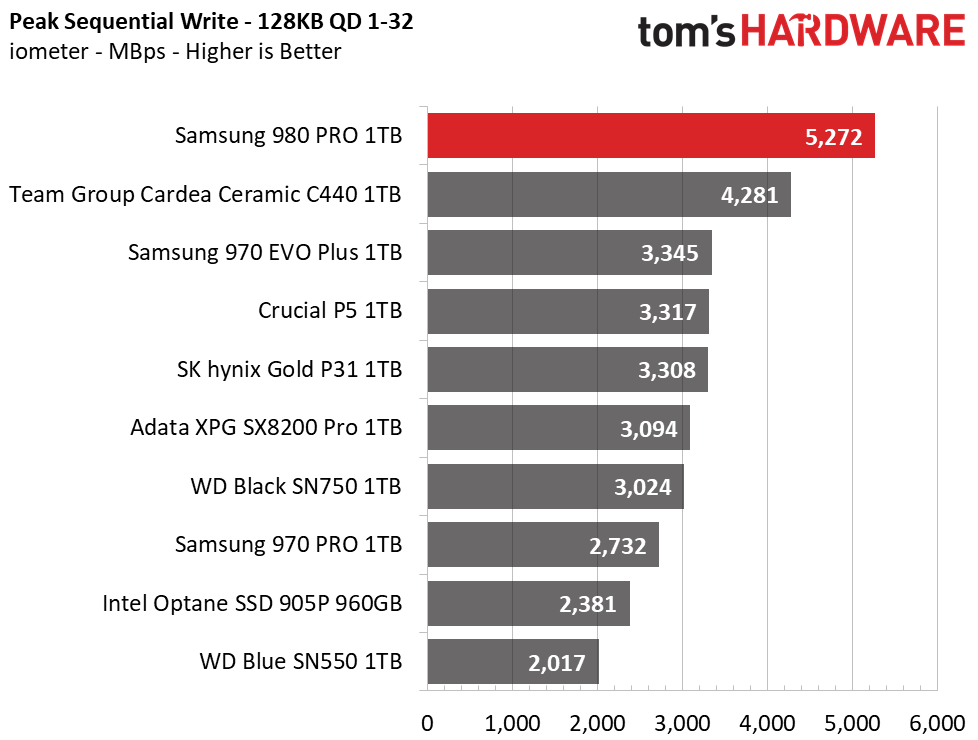
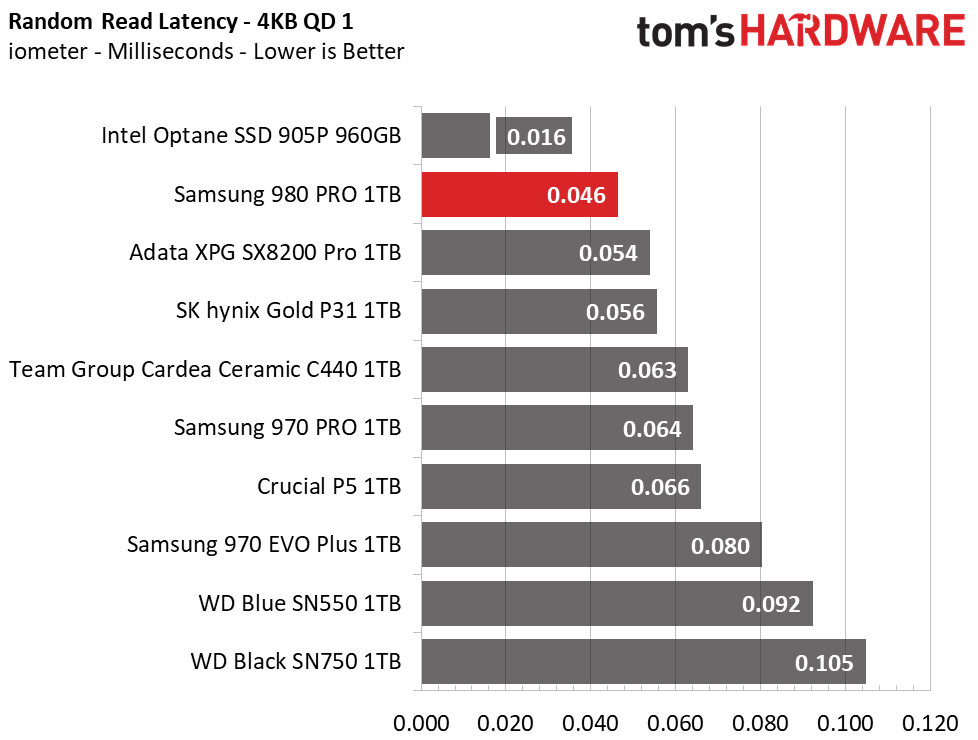
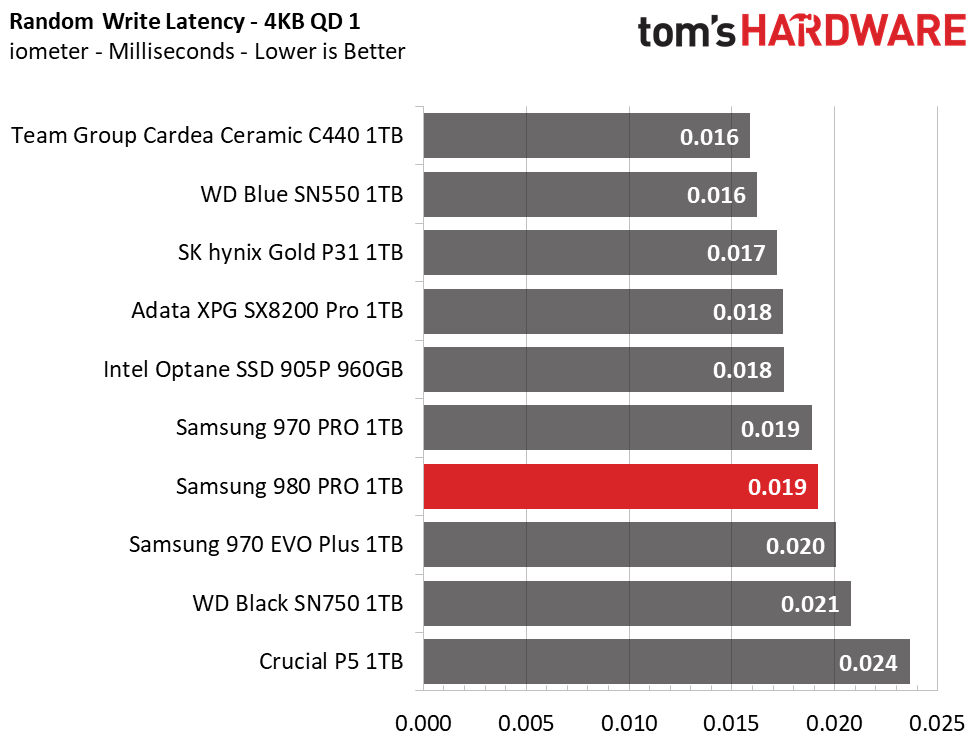
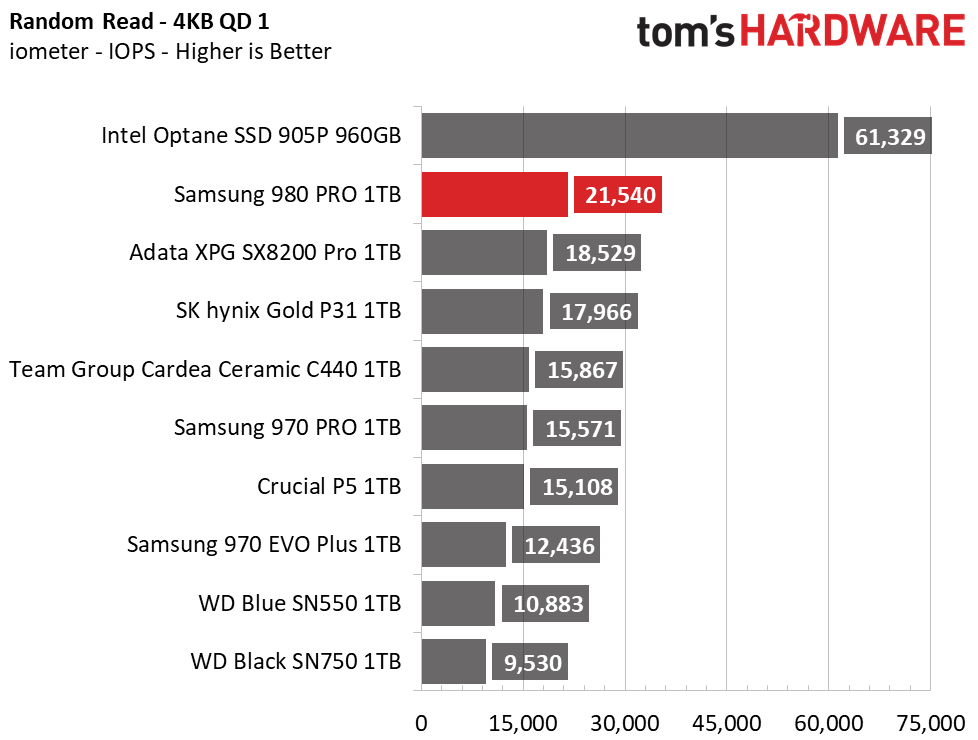
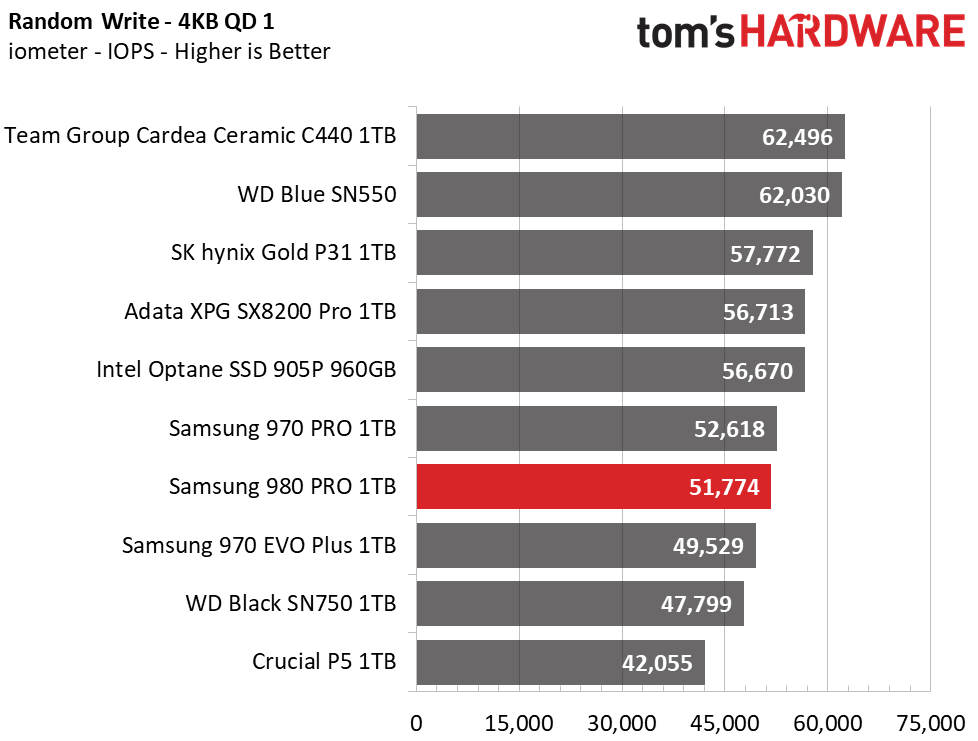
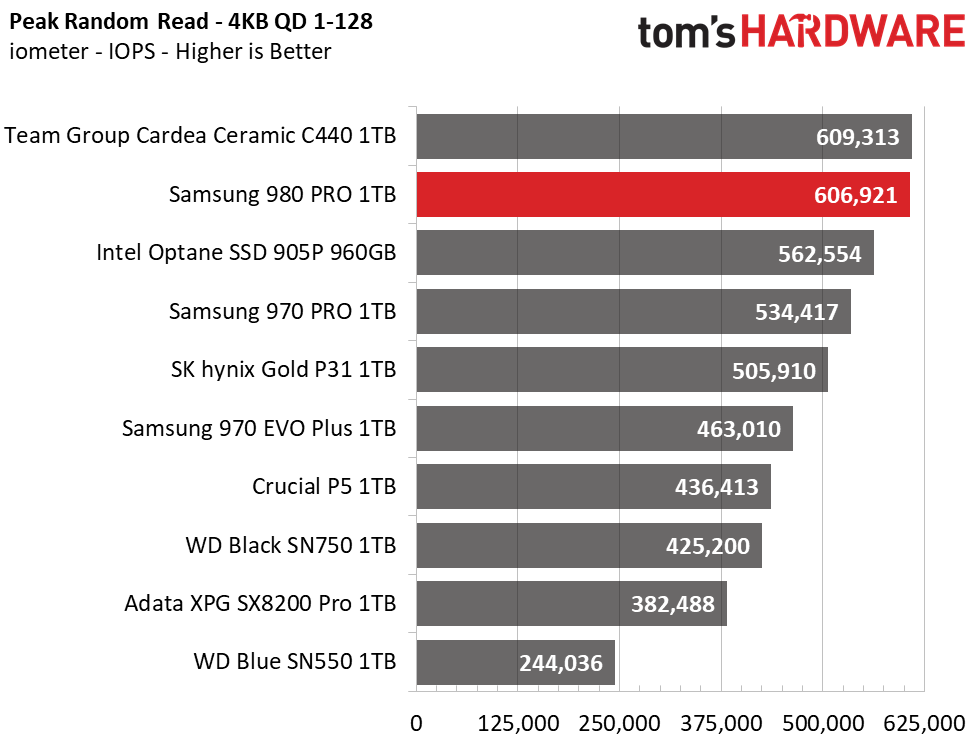

We tested Samsung’s 980 Pro at a QD (queue depth) of 1, representing most day-to-day file access at various block sizes. The 980 Pro overshadowed the Phison E16 based Team Group Cardea C440 and all other competitors. The 980 Pro’s peak sequential performance measured 7,138/5,272 MBps read/write, easily exceeding the 7/5 GBps rating.
When it comes to random performance, Intel’s Optane SSD 905P makes it clear that it won’t be beaten at low QDs. But Samsung’s 980 Pro has taken big strides forward. The drive delivers roughly 22,000 IOPS, responding within 0.46 ms (on average) to 4K random requests at QD1, Proving even more responsive than either Adata’s XPG SX8200 Pro or the SK hynix Gold P31.
In terms of raw IOPS capability, Team Group’s Cardea Ceramic C440 has the upper hand and overtakes the 980 Pro by a few thousand IOPS at high QDs.
Sustained Write Performance and Cache Recovery
Official write specifications are only part of the performance picture. Most SSDs implement a write cache, which is a fast area of (usually) pseudo-SLC Programmed flash that absorbs incoming data. Sustained write speeds can suffer tremendously once the workload spills outside of the cache and into the "native" TLC or QLC flash. We use iometer to hammer the SSD with sequential writes for 15 minutes to measure both the size of the write cache and performance after the cache is saturated. We also monitor cache recovery via multiple idle rounds.
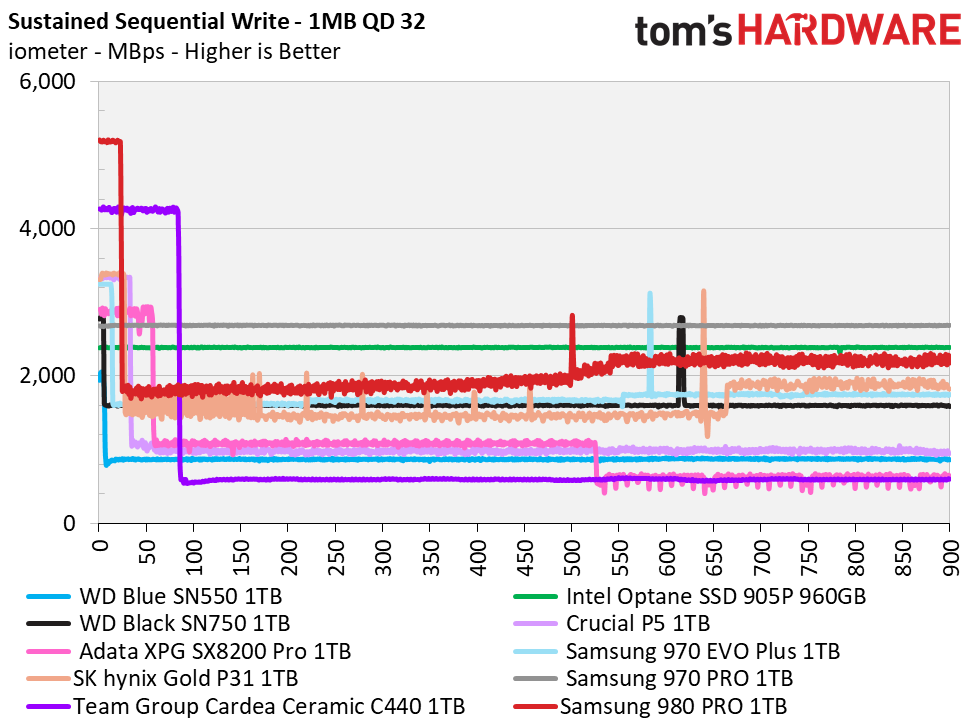
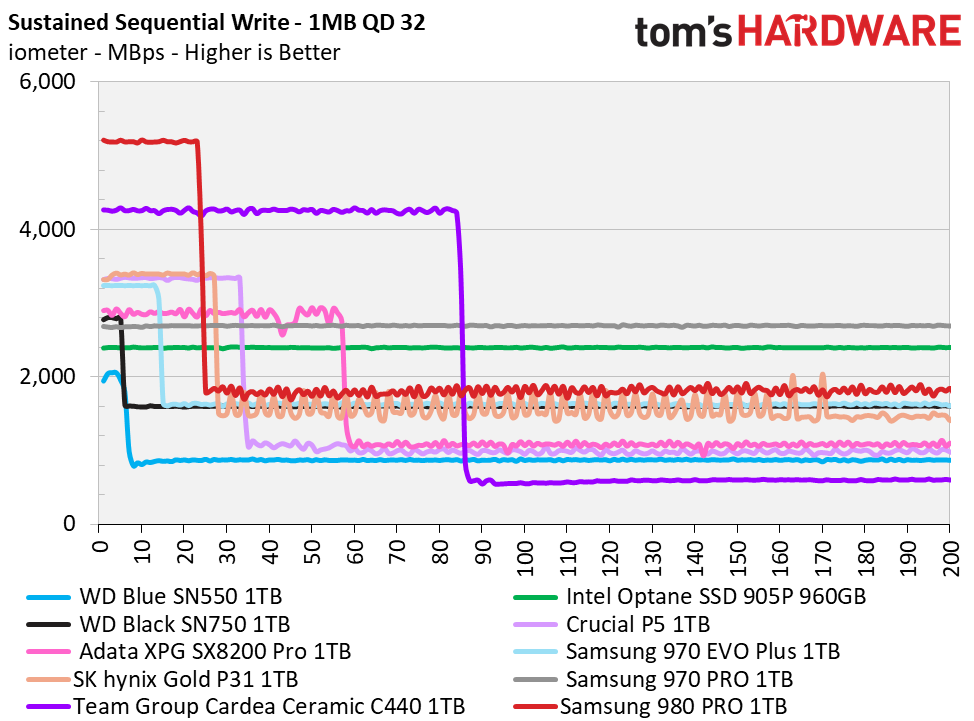
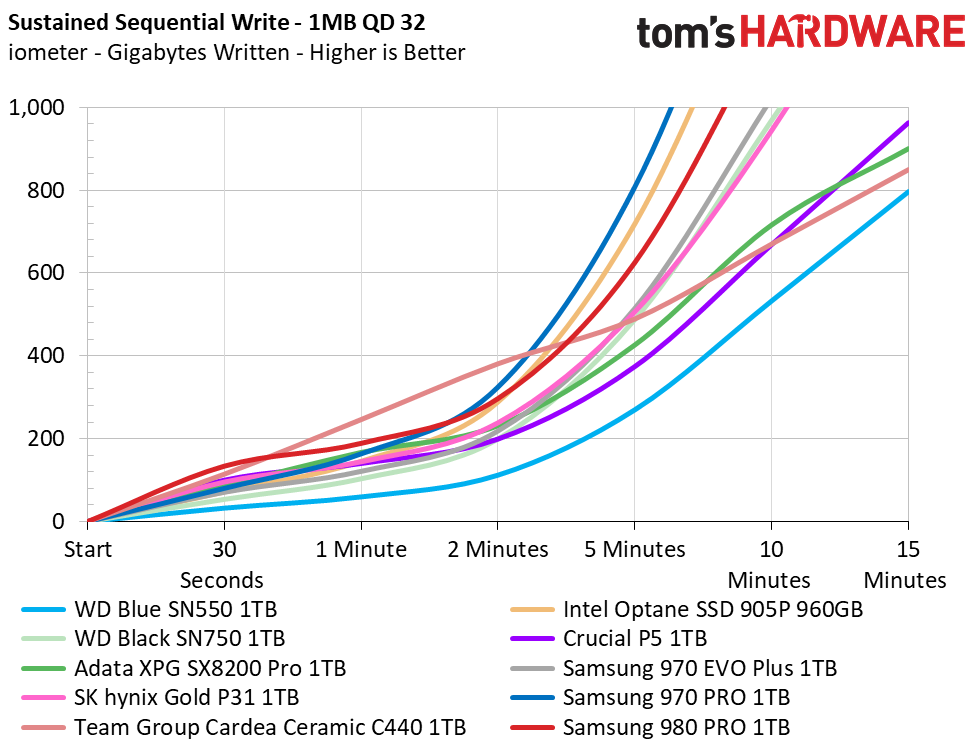
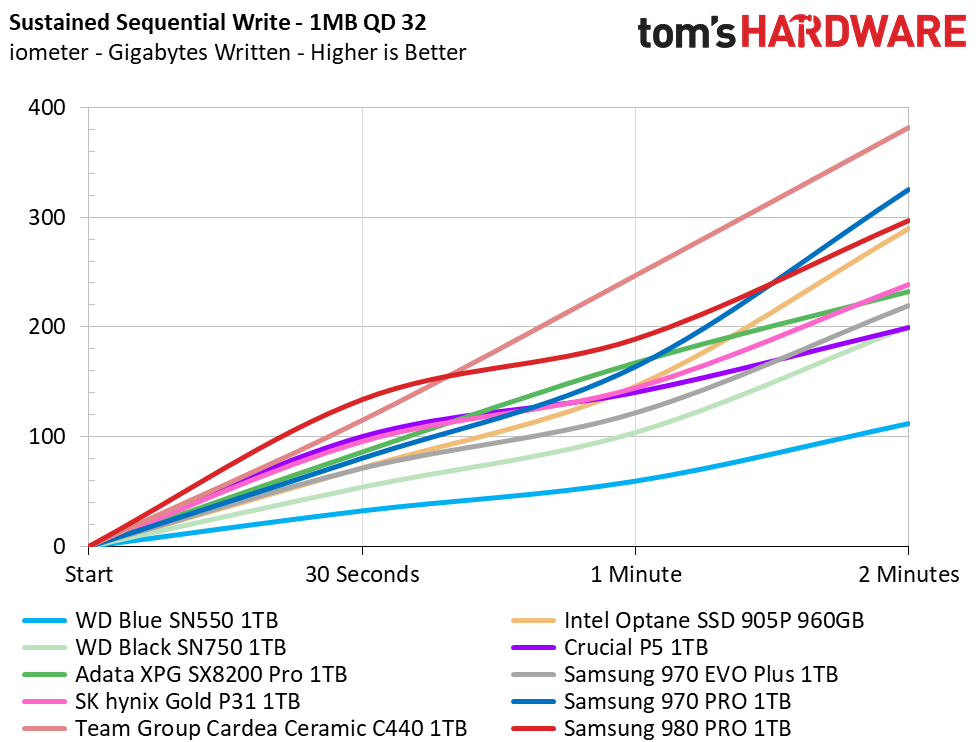
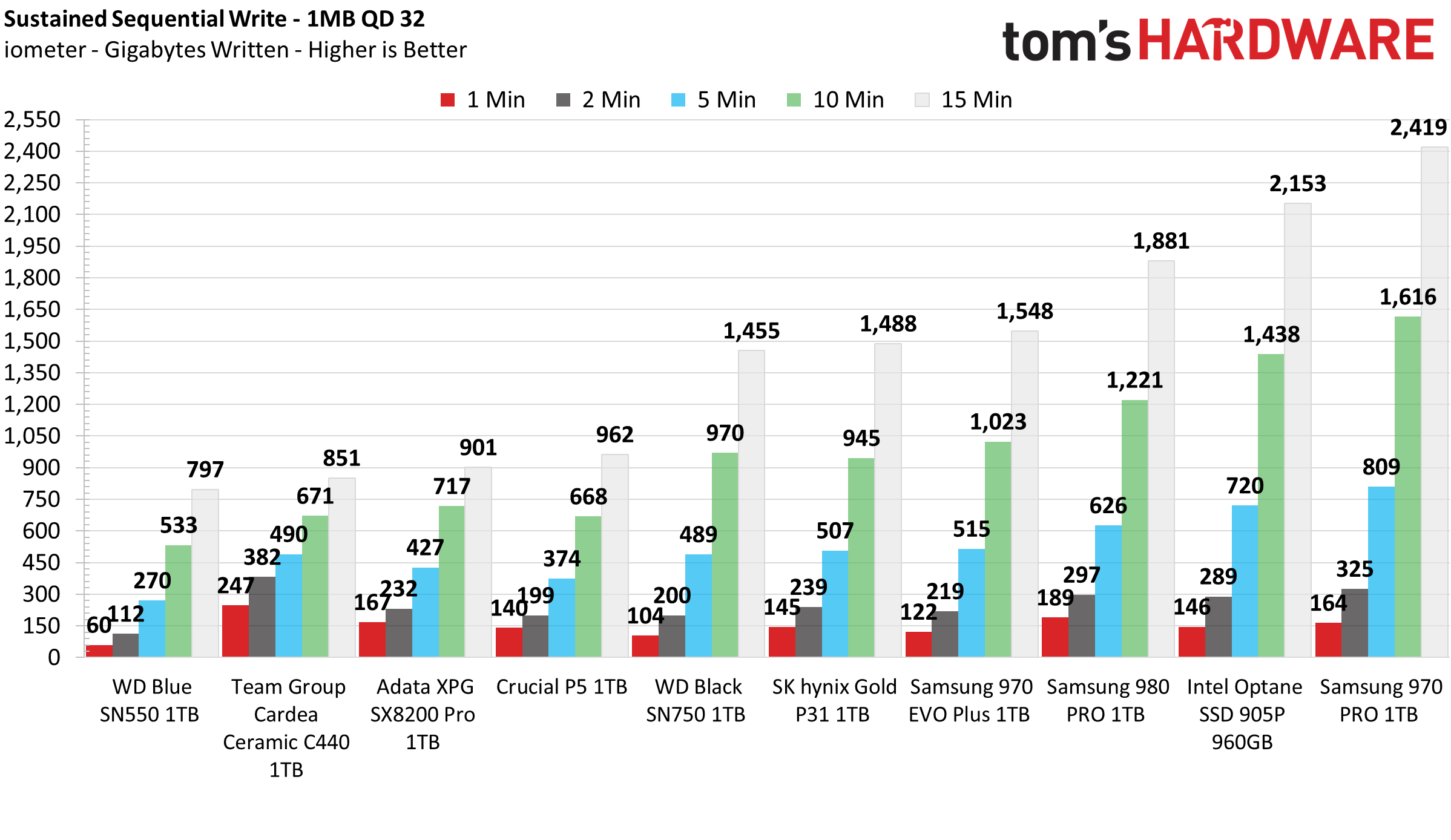
Samsung’s 1TB 980 Pro wrote at a rate of 5.2 GBps for roughly 120GB before the TurboWrite SLC cache filled. Once it began writing directly to the TLC flash, average performance measured 1.8GBps until full. After we filled the cache completely, performance increased to an average of 2.2 GBps.
Overall, this gives the 980 Pro very strong initial write performance for most applications, but it has slower direct-to-TLC write performance than the 970 Pro’s steady 2.7 GBps of performance. As a result, the 980 Pro trails its predecessor when hammered with writes over long periods.
After half an hour of idle time, Samsung's 980 Pro only recovered 6GB of the TurboWrite cache. So, instead of immediately recovering, it may take a few hours of idle time to refresh fully.
Power Consumption and Temperature
We use the Quarch HD Programmable Power Module to gain a deeper understanding of power characteristics. Idle power consumption is an important aspect to consider, especially if you're looking for a laptop upgrade. Some SSDs can consume watts of power at idle while better-suited ones sip just milliwatts. Average workload power consumption and max consumption are two other aspects of power consumption, but performance-per-watt is more important. A drive might consume more power during any given workload, but accomplishing a task faster allows the drive to drop into an idle state faster, which ultimately saves power.
We also monitor the temperature of the drive via the S.M.A.R.T. data and an IR thermometer to see when (or if) thermal throttling kicks in and how it impacts performance. Bear in mind that results will vary based on the workload and ambient air temperature.
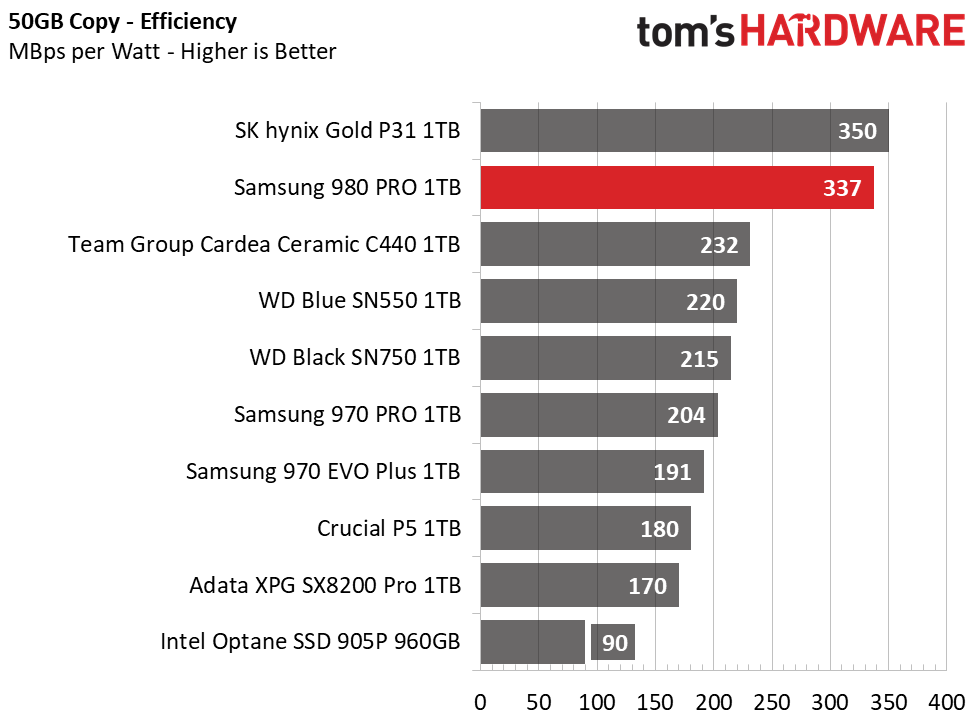
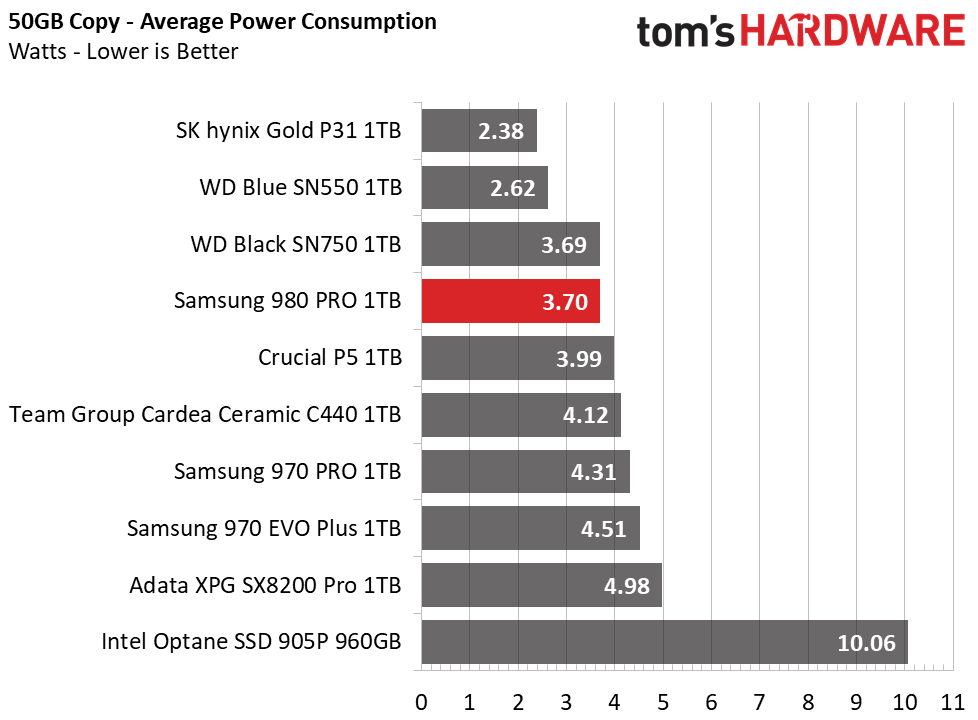
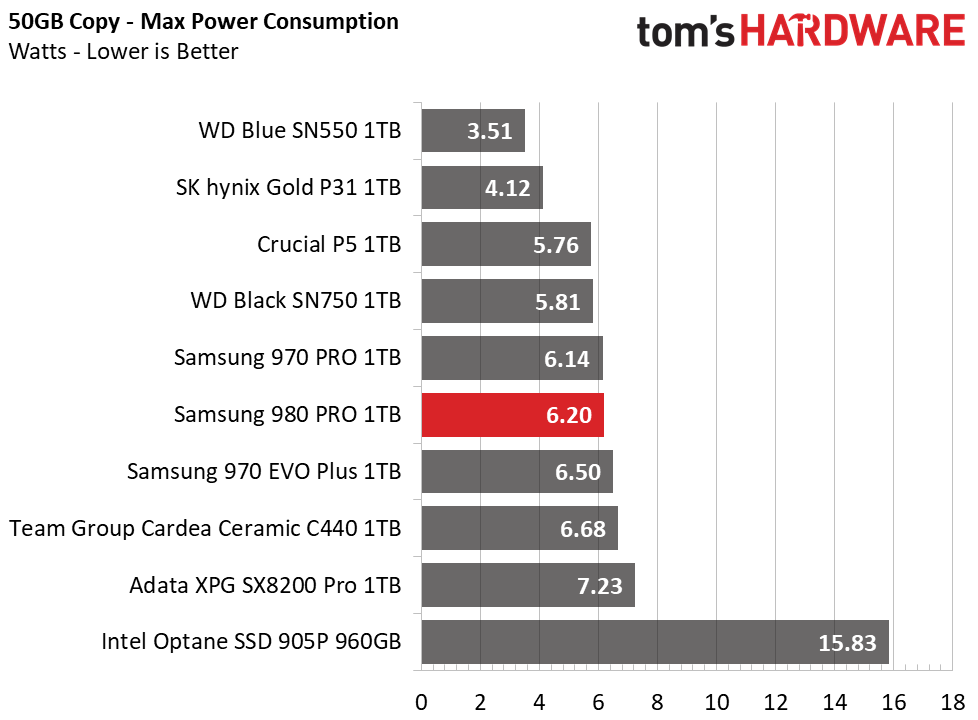

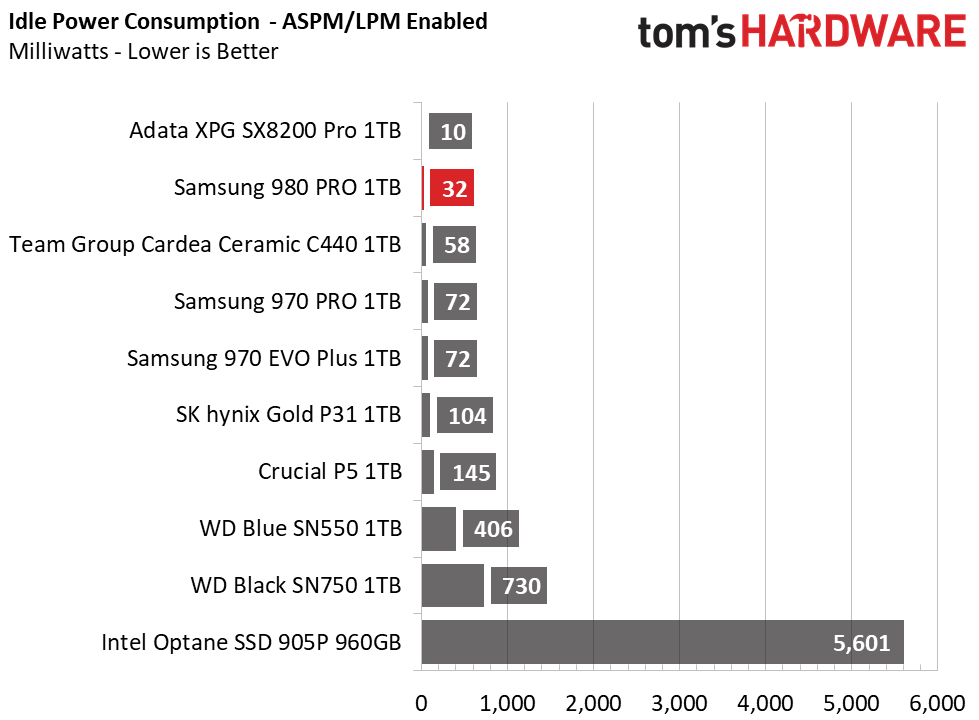
Samsung's 980 Pro comes in second place on our 50GB file copy efficiency chart, so it not only proves to be a very fast SSD, but it is also very efficient under load. The 980 Pro managed its average and max power consumption very well during the copy operation. Idle power consumption plummeted immediately after the drive completed the operation, just as it should. Improving upon the previous Phoenix controller, the new Gen4 Elpis controller enables the 980 Pro to consume just 32mW at idle, down from 72mW, on our desktop test bench.
With no airflow in a 24 degrees Celsius room, the SSD controller measured 50 degrees Celsius at idle with ASPM disabled, and the NAND measured a cool 40 degrees Celsius. We threw a few hundred gigabytes of data onto the SSD, and temperatures rose to 85 degrees Celsius on the controller's surface after 350GB of writes. Meanwhile, the NAND and DRAM both peaked at 81 degrees Celsius.
In most cases, like when you're gaming or browsing the web, you won't have to worry about thermal throttling. But if you hammer the device with many or large read and write requests often, we advise using the motherboard's heatsink or directing some airflow towards the SSD.
MORE: Best SSDs
MORE: How We Test HDDs And SSDs
MORE: All SSD Content
Current page: 1TB Performance Results
Prev Page 500GB Performance Results Next Page 2TB Performance Results
Sean is a Contributing Editor at Tom’s Hardware US, covering storage hardware.
-
dmitche31958 I would have liked to see how this compares to the Corsair MP600. No need to compare these to SATA SSDs but other PCI 4.0 are. While it's nice to see comparisons of this type they can lead one to believe that the items are better than they truly are.Reply -
derekullo What's the point of a Pro model with turbowrite?Reply
I guess every company has a "Netburst" -
seanwebster Reply
The Team Group Cardea Ceramic C440 and Corsair Force MP600 are the same hardware and near-identical firmware save for AES 256-bit encryption being unlocked on the MP600. You can basically just swap names since the performance figures are comparable. I wish I had a 500GB E16-based SSD to compare, but for now, the 1TB and up is all I got with that controller.dmitche31958 said:I would have liked to see how this compares to the Corsair MP600. No need to compare these to SATA SSDs but other PCI 4.0 are. While it's nice to see comparisons of this type they can lead one to believe that the items are better than they truly are. -
Rob1C After reading Tom's article: "Sabrent Crushes Samsung At Their Own Game: Builds World's Fastest M.2 SSD" I'd like to have seen it included in the charts in this article (save for a very brief mention).Reply -
Rognis I'm surprised the Sabrent pcie 4.0 TLC drive wasn't in the compared list, unless it's just so bad there wasn't a reason to add it?Reply -
Friesiansam 980 Pro is certainly quick but, by the time my 970 Pro goes belly-up, there'll be something quicker and cheaper with more durability.Reply -
mattkiss Why is the WD SN550 random read 4K QD1 iops so much lower than it's outstanding random write 4K QD1 iops? Just curious b/c I'm interested in the 1 TB version of the SN550.Reply -
0112358 No mention in the article, but current, other 7,000+ MB/s read-speed SSDs include:Reply
1) Gigabyte's AORUS Gen4 AIC 2 TB & 8 TB RAID card, with read speeds of up to 15,000 MB/s (via Phison’s 3D TLC PS5016-E16 controller), and
2) ADATA's XPG GAMMIX S70 PCIe 4.0 SSD -- up to 7,500 MB/s.
"Just sayin'..." -
0112358 Reply
The Samsung 980 is nearly 50% faster than Sabrent's best for read-speed...so there's that.Rognis said:I'm surprised the Sabrent pcie 4.0 TLC drive wasn't in the compared list, unless it's just so bad there wasn't a reason to add it? -
salgado18 Reply
Considering my 840 EVO is still going strong as a system and programs drive, you will probably upgrade to a PCIe 6.0 drive :sweatsmile:Friesiansam said:980 Pro is certainly quick but, by the time my 970 Pro goes belly-up, there'll be something quicker and cheaper with more durability.
